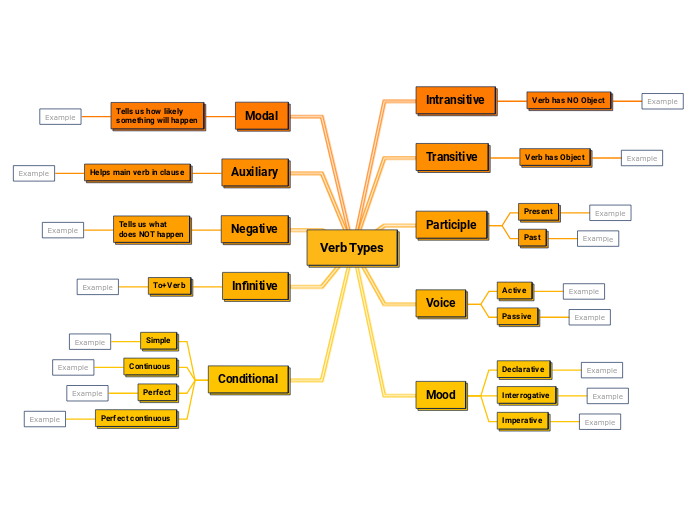{createBy}
{mapViews}
Verb Types
Use this mind map to improve your understanding of how verbs are used in different tenses and practice by creating different contexts.
Keywords: grammar, language

{createBy}
{mapViews}

More like this
As the main word in a sentence, the verb will generally describe an occurrence or an action.
Conditional verbs are used to create conditional sentences, which express hypothetical or unlikely situations. Conditional verbs can be used in the past, present, or future tense, and auxiliary verbs like can/could, will/would, and may/might are important in forming conditionals
An infinitive verb is essentially the base form of a verb with the word 'to' in front of it. When you use an infinitive verb, the 'to' is a part of the verb. It is not acting as a preposition in this case.
The negative verb forms are made by putting not after an auxiliary verb.
Auxiliary verbs are verbs such as have, be, may, do, shall, will, can, or must that are used with another verb to show the verb's tense, to form a question, etc.
A modal verb is a type of verb that is used to indicate modality. Commonly used modal verbs are can, could, must, should, had better, have to and sometimes need or dare.
Grammatical mood refers to the quality or form of a verb in a sentence. More specifically, mood denotes the tone of a verb in a sentence, so the intention of the writer or speaker is clear.
In grammar, the voice of a verb describes the relationship between the action that the verb expresses and the participants identified by its arguments.
A participle is a form of a verb that can be used as an adjective or combined with the verb to be to construct different verb tenses.
A transitive verb will only makes sense if it applies its action on an object.
An intransitive verb has two characteristics:
1.it is an action verb, expressing a doable activity
2.it will not have a direct object receiving the action
Create sentences with examples!
Mind maps help you brainstorm, establish relationships between concepts, organize and generate ideas.
However, mind map templates offer an easier way to get started, as they are frameworks that contain information about a specific subject with guiding instructions. In essence, mind map templates ensure the structure that combines all the elements of a specific subject and serves as a starting point for your personal mind map. They are a resource for providing a practical solution to create a mind map on a particular topic, either for business or education.
Mindomo brings you smart mind map templates that allow you to function and think effortlessly.
Descriptive topics
Topics with background text
Default branch
Removing the template data
You can choose from a variety of mind map templates from Mindomo's business or educational accounts, or you can create your own mind map templates from scratch. Any mind map can be transformed into a mind map template map by adding further guiding notes to one of its topics.